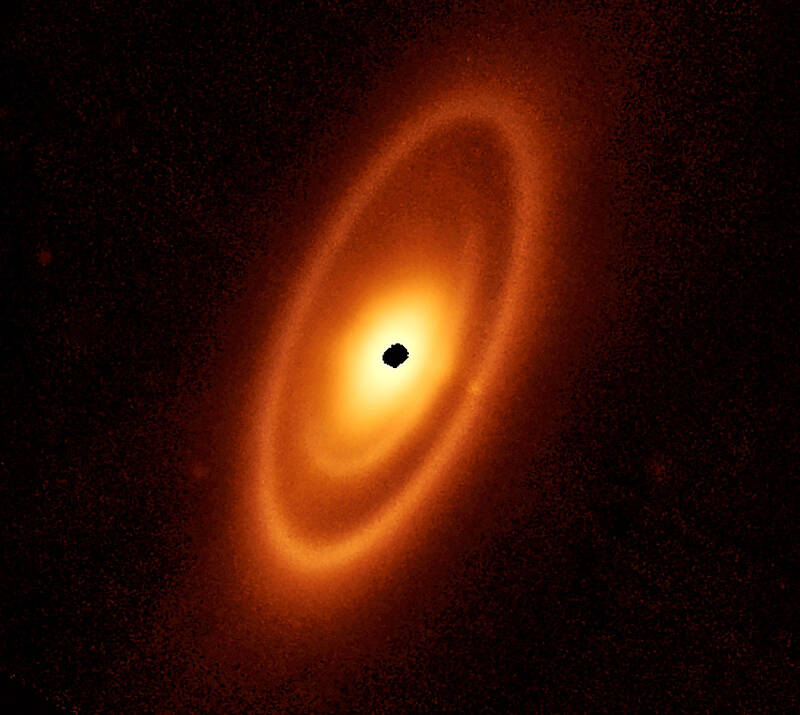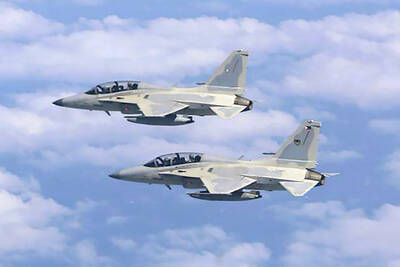There has been plenty of excitement in recent decades about planets detected orbiting various stars beyond our solar system. However, planets provide an incomplete picture of the complex framework that exists around stars, leaving out components like the belts of rocky and icy debris orbiting the sun.
Scientists on Monday unveiled observations by the James Webb Space Telescope showing new details about such features around a luminous star called Fomalhaut in the Milky Way galaxy. These observations of three concentric dusty rings of debris orbiting Fomalhaut provide the fullest view to date of such structures outside the solar system.
Fomalhaut, one of the brightest stars in our night sky and the brightest in the southern constellation Piscis Austrinus, is 25 light years from Earth.

Photo: Reuters
Astronomers first discovered a single belt of debris around Fomalhaut in 1983. Webb’s observations revealed two additional rings nearer the star — a bright inner one and a narrow intermediate one.
These three belts appear to be populated by objects called planetesimals, some of which are thought to join together early in a star system’s history to form planets while others remain as debris like asteroids and comets.
“Much like our solar system, other planetary systems harbor disks of asteroids and comets — leftover planetesimals from the epoch of planet formation — that continuously grind themselves down to micron-sized particles via collisional interactions,” said University of Arizona astronomer Andras Gaspar, lead author of the study published in the journal Nature Astronomy.
Fomalhaut is 16 times more luminous than the sun and almost twice as massive.
The three nested belts extend out to 22.5 billion kilometers from Fomalhaut, about 150 times the distance of Earth to the sun.
While no planets have been discovered yet around Fomalhaut, the researchers suspect the belts were carved out by gravitational forces exerted by unseen planets.
Our solar system has two such belts — the main asteroid belt between the rocky planet Mars and the gas giant Jupiter, and the Kuiper belt beyond the ice giant Neptune.
The gravitational influence of Jupiter, our solar system’s largest planet, corrals the main asteroid belt. The inner edge of the Kuiper belt, which is home to dwarf planets Pluto and Eris, as well as other icy bodies of varying sizes, is shaped by the outermost planet Neptune.
“The secondary gap we see in the system is a strong indication for the presence of an ice giant in the system,” Gaspar said.
The observations from Webb, which was launched in 2021 and began collecting data last year, were made by its Mid-Infrared Instrument (MIRI).
“Nearly all of the resolved images of debris disks thus far had been for the cold, outer regions analogous to the solar system’s Kuiper belt,” like Fomalhaut’s outer belt, said astronomer and study coauthor Schuyler Wolff of the University of Arizona’s Steward Observatory.
MIRI now can resolve the relatively warmer belts of material analogous to our main asteroid belt, Wolff said.
Studying these debris belts offers insight into planetary beginnings.
“Planets form within the primordial disks surrounding young stars. Understanding this formation process requires a complete understanding of how these disks form and evolve,” Wolff said.
“There are many open questions about how the dust in these disks coalesces to form planetary embryos, how the planetary atmospheres form, et cetera,” Wolff said.
“Debris disks are remnants of this planet formation process and their structure can provide valuable clues to the underlying planet population and the dynamical histories,” he added.

OPTIMISTIC: A Philippine Air Force spokeswoman said the military believed the crew were safe and were hopeful that they and the jet would be recovered A Philippine Air Force FA-50 jet and its two-person crew are missing after flying in support of ground forces fighting communist rebels in the southern Mindanao region, a military official said yesterday. Philippine Air Force spokeswoman Colonel Consuelo Castillo said the jet was flying “over land” on the way to its target area when it went missing during a “tactical night operation in support of our ground troops.” While she declined to provide mission specifics, Philippine Army spokesman Colonel Louie Dema-ala confirmed that the missing FA-50 was part of a squadron sent “to provide air support” to troops fighting communist rebels in

PROBE: Last week, Romanian prosecutors launched a criminal investigation against presidential candidate Calin Georgescu accusing him of supporting fascist groups Tens of thousands of protesters gathered in Romania’s capital on Saturday in the latest anti-government demonstration by far-right groups after a top court canceled a presidential election in the EU country last year. Protesters converged in front of the government building in Bucharest, waving Romania’s tricolor flags and chanting slogans such as “down with the government” and “thieves.” Many expressed support for Calin Georgescu, who emerged as the frontrunner in December’s canceled election, and demanded they be resumed from the second round. George Simion, the leader of the far-right Alliance for the Unity of Romanians (AUR), which organized the protest,

ECONOMIC DISTORTION? The US commerce secretary’s remarks echoed Elon Musk’s arguments that spending by the government does not create value for the economy US Secretary of Commerce Howard Lutnick on Sunday said that government spending could be separated from GDP reports, in response to questions about whether the spending cuts pushed by Elon Musk’s Department of Government Efficiency could possibly cause an economic downturn. “You know that governments historically have messed with GDP,” Lutnick said on Fox News Channel’s Sunday Morning Futures. “They count government spending as part of GDP. So I’m going to separate those two and make it transparent.” Doing so could potentially complicate or distort a fundamental measure of the US economy’s health. Government spending is traditionally included in the GDP because

Two daughters of an Argentine mountaineer who died on an icy peak 40 years ago have retrieved his backpack from the spot — finding camera film inside that allowed them a glimpse of some of his final experiences. Guillermo Vieiro was 44 when he died in 1985 — as did his climbing partner — while descending Argentina’s Tupungato lava dome, one of the highest peaks in the Americas. Last year, his backpack was spotted on a slope by mountaineer Gabriela Cavallaro, who examined it and contacted Vieiro’s daughters Guadalupe, 40, and Azul, 44. Last month, the three set out with four other guides